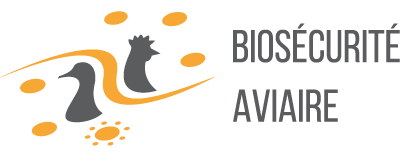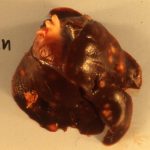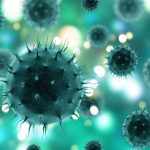“Red louse” is the main ectoparasite affecting laying hens.
The disease agent and its pathogenicity
The red louse or Dermanyssus gallinae is a haematophagous mite, of the suborder Gamasoidea, of the family Dermanyssidae. It is an intermittent parasite reproducing in the external environment with nocturnal haematophagy. Its reproductive cycle is quick, 5 to 9 days, with 5 stages of development: egg, larva, protonymph, deutonymph, adult. It is lucifugal.
The adult measures about 0.7*0.4mm. He has apparent stigmas between the 2nd and 3rd pair of legs. His hypostoma is sharp and toothless. The legs are grouped into a single front group. His cheliceras are long and thin. Its dorsal surface carries a single plate, with a triangular anal shield. The cuticle is transparent. The female has a colour varying from grey to red, depending on the blood ingested.
The female lays eggs in the host’s environment within 12-24 hours after her first blood meal. Each laying, of about 7 eggs each time, requires 1 prior meal. If the temperature is suitable, the eggs hatch within 48-72 hours. Larvae become adults in 2-4 days. They do not require any meals before they are transformed into protonymph. Proto-deutonymph and deutonymph-adult metamorphoses require 1 meal each time.
Lice can survive for several months without feeding.
It can be a vector of pathogens: Salmonella, viruses (Marek, Newcastle,…)
Another red louse has appeared in recent years in our regions. It is Ornythonissus sylviarum, anatomically very similar.
Epidemiological data
Red louse are frequently found in poultry houses of free-range laying hens or organic farming. Farms using cages may also be affected. Broiler farms are less prone to red lice infestations; animals have a short economic lifespan, and the cleaning and disinfection process between 2 strips is more strict.
Chickens are the most common hosts, but red louse can also be found in turkey farms, pigeons, canaries and wild species. They are also found on rodents, which can be a vector for introduction into the henhouse. Finally, humans can also be a host (itching).
Most infestations occur between October and March.
The problem of red lice is on the rise due to the emergence of acaricide resistance, and the prohibition to treat hens or their immediate environment during egg laying with products that may leave residues in the eggs.
Lice are afraid of light and only move at night. They are only found on their hosts during the blood meal. Their usual habitats are crevices, cracks, alveoli or crevasses, in certain materials: egg strips, feeder bases, cage walls. They are also found a lot in wooden equipment (perches, nests, gratings). They are also found in dry droppings or feather piles.
Clinical manifestations of the disease
The consequences of the presence of red lice in a farm are mainly economic.
Red louse causes exacerbated nervousness in animals, causing pickling and cannibalism problems. It can cause egg loss, increased consumption, anaemia (when massive infestations), mortality and eggs stained by crushed lice (red spots on the shells). In some cases, lice can cause mortality.
With D. gallinae, the animal has anemia without bone marrow damage, unlike O. sylviarum.
The diagnosis
Diagnosis is made by observing parasites or their droppings on birds or in the external environment.
Disease prevention and control
Currently there is no solution to permanently eradicate red lice from a building. The strategy is based mainly on prevention with the objective of limiting the red lice population during the crawl space to a level low enough not to disturb the next batch. Often, after 3-4 months, we have an upsurge. It is also recommended to use flashing lights at night, which can improve the cleanliness of the eggs.
Natural products
They are allowed regardless of the production method. Their cost is high. They do not eliminate lice but limit their population to a level compatible with bird welfare. They are safe for the animal and the user, do not cause residues in eggs or meat and do not require a waiting period.
These include silica-based products that destroy the insect’s cuticle by causing its dehydration, and products based on plant extracts that block their digestive and/or respiratory function. There is also a spinosad-based product on the market.
There are also natural predators of lice: Taurrus pro and Androlis pro. One example is the DDRA: a substance secreted in the uropygial glands of ducks.
Chemical solutions
There are different categories of products: organophosphates (many effective molecules, reduced costs, all usable in the absence of animals: phoxim, azamethiphos, dichlorvos, trichlorfon). Etofenprox (contact action)
The treatment is applied by spraying or thermonebulisation. Their use is prohibited in organic farming.
Gassing can also be carried out with methyl bromide, an effective but expensive technique.
There is also a new Phoxim-based acaricide (organophosphorus) on the market that can be sprayed on surfaces in the presence of animals (without withdrawal period for eggs). Broad spectrum biocides based on quaternary ammonium, glutaraldehyde and deltamethrin (insecticide) are also available on the market.
There is a new molecule: the fluralaner (placed in drinking water)
